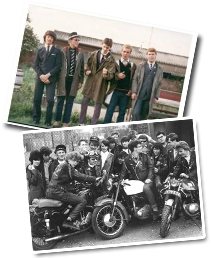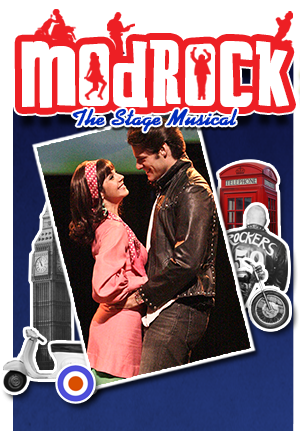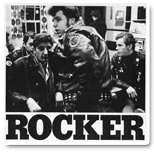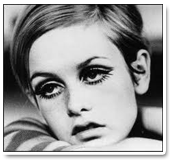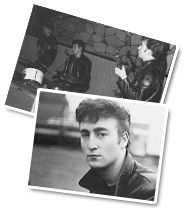
The Mods and Rockers were conflicting British youth subcultures of the early-mid 1960s. Riots between Mods and Rockers broke out in seaside resort towns in Southern England during this time and sparked a moral panic about British youths. The Rockers were motorcyclists, wearing clothes such as black leather jackets. The Mods were scooter riders, wearing suits and clean-cut outfits. By the late 1960s, the two subcultures had faded from public view and media attention turned to two new emerging youth subcultures — the hippies and the skinheads. However for a brief period between 1963 and 1966 the Mods and Rockers, both with British working class roots, dominated the pop culture and it was within this cultural context that the sounds of the British Music Invasion developed and world fashion and cultural trends were invented.
Rocker males wore black leather jackets, denim jeans, t-shirts and heavy boots and rode Triumph motorcycles. Rocker females wore much the same with some opting for tight black Capri pants, high-heels and had beehive hairdos. Elvis and the 50’s US motorcycle culture were their inspiration. The Mod males often wore suits, ‘drainpipe’ pants, pointy shoes and what they perceived to be the latest fashion while driving scooters like Vespas and Lambrettas.
The Mod females embraced all of the latest trends, 'Sassoon' hairstyles including the ‘bob’, short, colorful dresses that were preferably ‘Mary Quant’ and ‘go go’ boots. The Rockers considered Mods to be weedy, effeminate snobs, and Mods saw Rockers as out of touch, oafish and grubby. Musically there was not much common ground. Rockers generally favored 1950s rock and roll, mostly by artists like Elvis Presley, Eddie Cochran and Gene Vincent Mods listened to 1960s ska music, soul and R&B, as well as British bands such as The Who, The Yardbirds and The Kinks.
Looking at the evolution of the greatest rock band of all time, the Beatles, you can see the significant impact of both Rocker and Mod culture. In their early days the Beatles emulated and dressed like Rockers, had their hair combed in the Rocker’s style and they maintained this look while performing in Hamburg when they first began to catch fire. By the time of their appearance on the Ed Sullivan Show on February 9, 1964 they were, however, wearing Mod suits and sporting their famous ‘mop head’ haircuts.
By 1967 the Beatles had long hair and were now enjoying a ‘hippie’ lifestyle while creating their classic’s “Sergeant Peppers Lonely Hearts Club Band” and “Abbey Road” albums and the Rockers and Mods were, pretty much, symbols of the past. In the short period in the early sixties, however, numerous fashion trends emerged and some of the best music ever written was recorded by British bands that remain iconic artists to this day.

In the United Kingdom, Rockers were often engaged in brawls with Mods. BBC News stories from May 1964 stated that Mods and Rockers were jailed after riots in seaside resort towns in Southern England, such as Margate, Brighton, Bournemouth and Clacton. Mods sometimes sewed fish hooks or razor blades into the backs of their lapels to shred the fingers of assailants; the same thing was done by Teddy Boys in the 1950s. Weapons were often in evidence; coshes, bike chains and flick knives being favored.
The Mods and Rockers conflict led sociologist Stanley Cohen to develop the term moral panic in his study Folk Devils and Moral Panics, which examined media coverage of the Mod and Rocker riots in the 1960s. Although Cohen admits that Mods and Rockers had some fights in the mid-1960s, he argues that they were no different to the evening brawls that occurred between youths throughout the 1950s and early 1960s, both at seaside resorts and after football games. He claims that the UK media turned the Mod subculture into a negative symbol of delinquent and deviant status.
The conflict came to a head at Clacton during the Easter weekend of 1964. Round two took place on the south coast of England, where Londoners head for seaside resorts on Bank Holidays. Over the Whitsun weekend (May 18 and 19, 1964), thousands of Mods descended upon Margate, Broadstairs and Brighton to find that an inordinately large number of Rockers had made the same holiday plans. Within a short time, marauding gangs of Mods and Rockers were openly fighting, often using pieces of deckchairs. The worst violence was at Brighton, where fights lasted two days and moved along the coast to Hastings and back; hence the Second Battle of Hastings tag. A small number of Rockers were isolated on Brighton beach where they – despite being protected by police – were overwhelmed and assaulted by Mods. Eventually calm was restored and a judge levied heavy fines, describing those arrested as sawdust Caesars.
Newspapers described the Mod and Rocker clashes as being of "disastrous proportions", and labeled Mods and Rockers as "vermin" and "louts". Newspaper editorials fanned the flames of hysteria, such as a Birmingham Post editorial in May 1964, which warned that Mods and Rockers were "internal enemies" in the UK who would "bring about disintegration of a nation's character". The magazine Police Review argued that the Mods and Rockers' purported lack of respect for law and order could cause violence to "surge and flame like a forest fire".
Cohen argues that as media hysteria about knife-wielding, violent Mods increased, the image of a fur-collared anorak and scooter would "stimulate hostile and punitive reactions". As a result of this media coverage, two British Members of Parliament travelled to the seaside areas to survey the damage, and MP Harold Gurden called for a resolution for intensified measures to control hooliganism. One of the prosecutors in the trial of some of the Clacton brawlers argued that Mods and Rockers were youths with no serious views, who lacked respect for law and order. Cohen says the media used possibly faked interviews with supposed Rockers such as "Mick the Wild One". As well, the media would try to get mileage from accidents that were unrelated to mod-rocker violence, such as an accidental drowning of a youth, which got the headline "Mod Dead in Sea".
Eventually, when the media ran out of real fights to report, they would publish deceptive headlines, such as using a subheading "Violence", even when the article reported that there was no violence at all. Newspaper writers also began to associate Mods and Rockers with various social issues, such as teen pregnancy, contraceptives, amphetamines, and violence.
And soon thereafter the youth culture morphed into the hippie culture and the press fascination turned psychedelic and the Mods and Rockers, mostly, were forgotten.
For a brief and glorious time between 1963 and 1966 the British working class kids identified as Mods and Rockers dominated the pop culture. It was a magnificent time to be young and to be part of a wave that changed the course of music and culture.
